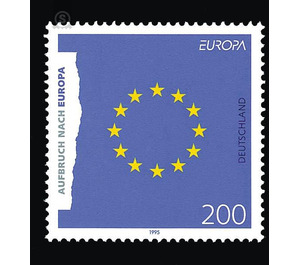Europe: peace and freedom - Germany / Federal Republic of Germany 1995 - 200 Pfennig
Theme: History & Politics
| Country | Germany / Federal Republic of Germany |
| Issue Date | 1995 |
| Face Value | 200.00 |
| Color | blue |
| Perforation | K 13 3/4 |
| Printing Type | Multicolor offset printing |
| Stamp Type | Postage stamp |
| Item Type | Stamp |
| Chronological Issue Number | 1664 |
| Chronological Chapter | GER-BRD |
| SID | 153383 |
| In 34 Wishlists | |
With the unconditional surrender of the German Wehrmacht on 8 May 1945, German history seemed to have reached a zero point. Not only had the National Socialist rule collapsed; The war unleashed by the German Reich in 1939 had also destroyed the German nation state. At the summit conference in Potsdam from July 17 to August 2, 1945, the Allies took decisions on the complete annihilation of the German armaments potential, the condemnation and punishment of war criminals, and the cleansing of political life in Germany from National Socialism and militarism. In principle, the victorious powers were also united by a democratic reconstruction of Germany. At the same time, this laid the foundation for Germany's return to the circle of European peoples. Already in 1946, Winston Churchill had spoken out for "a kind of unified states of Europe." On April 16, 1948, 17 states and the military governors of the three western occupation zones of Germany founded the European economic organization OEEC in Paris. In March 1948, some Western European states had already formed a defensive alliance, which was expanded to NATO in April 1949 in the wake of the onset of the Cold War under the leadership of the US. On May 5, 1949, ten European countries signed the founding charter of the Council of Europe in London. The Federal Republic became full member in May 1951. (Text: Federal Agency for Civic Education, Bonn)


